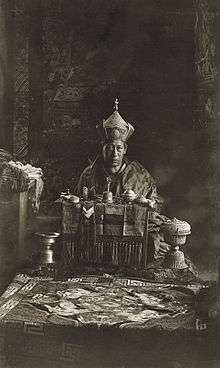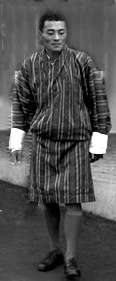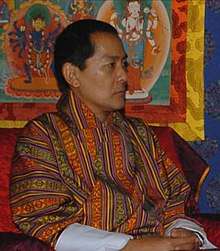List of rulers of Bhutan
Bhutan was founded and unified as a country by Ngawang Namgyal, 1st Zhabdrung Rinpoche in the mid–17th century. After his death in 1651, Bhutan nominally followed his recommended "dual system of government". Under the dual system, government control was split between a secular leader, the Druk Desi (འབྲུག་སྡེ་སྲིད་, aka Deb Raja);[nb 1] and a religious leader, the Je Khenpo (རྗེ་མཁན་པོ་).
| King of Bhutan | |
|---|---|
 | |
| Incumbent | |
.jpg) | |
| Jigme Khesar Namgyel Wangchuck since 9 December 2006 | |
| 5th Dragon King | |
| Details | |
| Style | His Majesty |
| Heir presumptive | Jigme Namgyel Wangchuck |
| First monarch | Ugyen Wangchuck |
| Formation | 17 December 1907 |
| Residence | Samteling Palace, Thimpu |
 |
|---|
| This article is part of a series on the politics and government of Bhutan |
|
Monarchy |
|
Government |
Both the Druk Desi and Je Khenpo were under the nominal authority of the Zhabdrung Rinpoche, a reincarnation of Ngawang Namgyal. In practice however, the Zhabdrung was often a child under the control of the Druk Desi, and regional penlops often administered their districts in defiance of the power of the Druk Desis until the rise of the unified House of Wangchuck in 1907.[1]
Since the rise of the unified House of Wangchuck in 1907, the Druk Gyalpo (འབྲུག་རྒྱལ་པོ་; lit. "Dragon King") have been the head of state of the Kingdom of Bhutan.
Druk Desis (1650–1905)
Below appears the list of Druk Desis throughout the existence of the office. Officeholders were initially appointed by Zhabdrung Ngawang Namgyal, though after his death the Je Khenpo and civil government decided appointments.
Italics indicate coregencies and caretaker governments, which are not traditionally separately numbered.

| No. | Name | Date of Birth | Reign start | Reign end | Date of Death |
|---|---|---|---|---|---|
| 1 | Tenzin Drukgye | 1591 | 1650 | 1655 | 1655 |
| 2 | Langonpa Tenzin Drukdra | 1655 | 1667 | 1667 | |
| 3 | Chhogyel Minjur Tenpa | 1667 | 1680 | 1691 | |
| 4 | Gyalsey Tenzin Rabgye | 1638 | 1680 | 1694 | 1696 |
| 5 | Gedun Chomphel | 1695 | 1701 | 1701 | |
| 6 | Ngawang Tshering | 1701 | 1704 | ||
| 7 | Umze Peljor | 1704 | 1707 | 1707 | |
| 8 | Druk Rabgye | 1707 | 1719 | 1729 | |
| 9 | Ngawang Gyamtsho | 1719 | 1729 | 1729 | |
| 10 | Mipham Wangpo | 1729 | 1736 | ||
| 11 | Khuwo Peljor | 1736 | 1739 | ||
| 12 | Ngawang Gyaltshen | 1739 | 1744 | ||
| 13 | Sherab Wangchuk | 1744 | 1763 | ||
| 14 | Druk Phuntsho | 1763 | 1765 | ||
| 15 | Wangzob Druk Tenzin I | 1765 | 1768 | ||
| 16 | Sonam Lhundub[3][table 1] | 1768 | 1773 | 1773 | |
| 17 | Kunga Rinchen | 1773 | 1776 | ||
| 18 | Jigme Singye | 1742 | 1776 | 1788 | 1789 |
| 19 | Druk Tenzin | 1788 | 1792 | ||
| 20 | Umzey Chapchhab | 1792 | 1792 | 1792 | |
| 21 | Chhogyel Sonam Gyaltshen (Tashi Namgyel) | 1792 | 1799 | ||
| 22 | Druk Namgyel | 1799 | 1803 | ||
| 23 | Chhogyel Sonam Gyaltshen (Tashi Namgyel) (2nd reign) | 1803 | 1805 | ||
| 24 | Sangye Tenzin | 1805 | 1806 | ||
| 25 | Umzey Parob | 1806 | 1808 | ||
| 26 | Byop Chhyoda | 1807 | 1808 | ||
| 27 | Tulku Tsulthrim Daba | 1790 | 1809 | 1810 | 1820 |
| 28 | Zhabdrung Thutul (Jigme Dragpa) | 1810 | 1811 | ||
| 29 | Chholay Yeshey Gyaltshen | 1781 | 1811 | 1815 | 1830 |
| 30 | Tshaphu Dorji Namgyel | 1815 | 1815 | ||
| 31 | Sonam Drugyel | 1815 | 1819 | ||
| 32 | Gongzim Tenzin Drukda | 1819 | 1823 | ||
| 33 | Chhoki Gyaltshen | 1823 | 1831 | ||
| 34 | Dorji Namgyal | 1831 | 1832 | ||
| 35 | Adab Thinley | 1832 | 1835 | ||
| 36 | Chhoki Gyaltshen (2nd reign) | 1835 | 1838 | ||
| 37 | Dorji Norbu | 1838 | 1850 | ||
| 38 | Wangchuk Gyalpo | 1850 | 1850 | ||
| 39 | Zhabdrung Thutul (Jigme Norbu) (in Thimphu) | 1850 | 1852 | ||
| Chagpa Sangye (in Punakha) | 1851 | 1852 | |||
| 40 | Damchho Lhundrup | 1852 | 1854 | ||
| 41 | Jamtul Jamyang Tenzin | 1854 | 1856 | ||
| 42 | Kunga Palden (in Punakha) | 1856 | 1860 | ||
| Sherab Tharchin (in Thimphu) | 1856 | 1860 | |||
| 43 | Phuntsho Namgyel (Nazi Pasang) | 1860 | 1863 | ||
| 44 | Tshewang Sithub | 1863 | 1864 | ||
| Tsulthrim Yonten | 1864 | 1864 | |||
| 45 | Kagyud Wangchuk | 1864 | 1864 | ||
| 46 | Tshewang Sithub (2nd reign) | 1865 | 1867 | ||
| 47 | Tsondul Pekar | 1867 | 1870 | ||
| 48 | Jigme Namgyel | 1825 | 1870 | 1873 | 1881 |
| 49 | Kitshab Dorji Namgyel | 1873 | 1879 | ||
| Jigme Namgyel (2nd reign) | 1877 | 1878 | |||
| Kitsep Dorji Namgyel (2nd reign) | 1878 | 1879 | |||
| 50 | Chhogyel Zangpo | March 1879 | June 1880 | 1880 | |
| Jigme Namgyel (3rd reign) | June 1880 | July 1881 | |||
| 51 | Lam Tshewang | 1836 | July 1881 | May 1883 | 1883 |
| 52 | Gawa Zangpo | May 1883 | August 1885 | ||
| 53 | Sangye Dorji | 1885 | 1901 | 1901 | |
| 54 | Choley Yeshe Ngodub | 1851 | 1903 | 1905 | 1917 |
Notes:
| |||||
Kings of Bhutan (1907–present)
The Bhutanese monarchy was established on 17 December 1907, unifying the country under the control of the Wangchuck family, hereditary penlops (governors) of Trongsa district. The king of Bhutan, formally known as the Druk Gyalpo ("Dragon King"), also occupies the office of Druk Desi under the dual system of government. Since the enactment of the Constitution of 2008, the Druk Gyalpo has remained head of state, while the Prime Minister of Bhutan acts as executive and head of government in a parliamentary democracy.[4]
| Name | Lifespan | Reign start | Reign end | Notes | Family | Image |
|---|---|---|---|---|---|---|
| Ugyen | 1862 – 26 August 1926 (aged 64) | 17 December 1907 | 26 August 1926 | Wangchuck |  | |
| Jigme | 1905 – 30 March 1952 (aged 47) | 26 August 1926 | 30 March 1952 | Son of Ugyen | Wangchuck |  |
| Jigme Dorji | 2 May 1929 – 21 July 1972 (aged 43) | 30 March 1952 | 21 July 1972 | Son of Jigme | Wangchuck |  |
| Jigme Singye | 11 November 1955 | 21 July 1972 | 14 December 2006 (abdicated) | Son of Jigme Dorji | Wangchuck |  |
| Jigme Khesar Namgyel | 21 February 1980 | 14 December 2006 | Incumbent | Son of Jigme Singye | Wangchuck | .jpg) |
See also
- Druk Desi
- Je Khenpo
- Dual system of government
- Druk Gyalpo
- Druk Gyaltsuen
- House of Wangchuck
- Constitution of Bhutan
- History of Bhutan
Notes
- The original title is སྡེ་སྲིད་ཕྱག་མཛོད་; desi chhak zod.
References
- Worden, Robert L.; Savada, Andrea Matles (ed.) (1991). "Chapter 6 – Bhutan: Administrative Integration and Conflict with Tibet, 1651–1728". Nepal and Bhutan: Country Studies (3rd ed.). Federal Research Division, United States Library of Congress. ISBN 0-8444-0777-1.CS1 maint: extra text: authors list (link)
- Dorji, C. T. (1995). A Political & Religious History of Bhutan, 1651–1906. Delhi, India: Sangay Xam; Prominent Publishers.
-

- "The Constitution of the Kingdom of Bhutan" (PDF). Government of Bhutan. 18 July 2008. Archived from the original (PDF) on 6 July 2011. Retrieved 8 October 2010.
Further reading
- Petech, Luciano (1972). The Rulers of Bhutan c. 1650–1750. Oriens Extremus. 19. Hamburg: Zeitschrift für Sprache, Kunst und Kultur der Länder des Fernen Ostens. pp. 203–213.
- Dorji, C. T. (1997). Blue annals of Bhutan. Vikas.
- Truhart, Peter (1985). Regents of nations: systematic chronology of states and their political representatives in past and present. Regents of Nations: Systematic Chronology of States and Their Political Representatives in Past and Present : a Biographical Reference Book, Peter Truhart. 2. Saur. pp. 1005 et seq. ISBN 3-598-10493-6.
- Dorji, C. T. (2004). Sources of Bhutanese history. Prominent Publishers. pp. 330 et seq. ISBN 81-86239-16-2.
- Younghusband, Sir Francis Edward (1910). India and Tibet: a history of the relations which have subsisted between the two countries from the time of Warren Hastings to 1910; with a particular account of the mission to Lhasa of 1904. J. Murray.